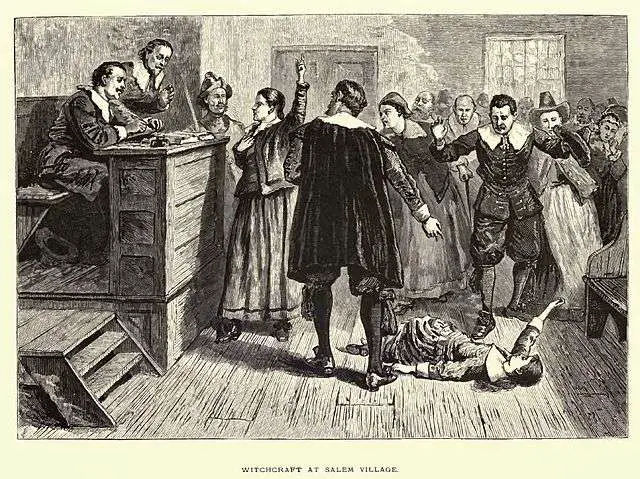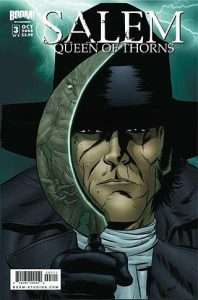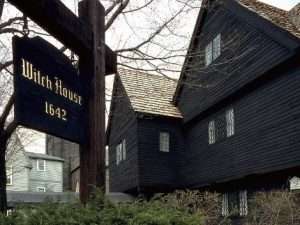People still can’t seem to get enough of the Salem witch trials, which remain a mainstay of popular culture more than three centuries after they started.

“Witchcraft at Salem Village,” in Pioneers in the Settlement of America, Vol. 1, by William A. Crafts
Writers and artists used the Salem witch trials to show why government persecutes the innocent, how the ignorant masses are manipulated or why people get caught up in hysteria. Or sometimes they just used the trials to entertain.
For more than a century, tourists to Salem, The Witch City, have been buying witch souvenirs and visiting witch houses.

A Salem gift shop
Why the continued fascination with the Salem witch trials? One reason is that a lot of people have ancestors involved in the hysteria. In addition to the 20 people tried and executed, magistrates indicted 200 people for witchcraft. The scope of the hysteria led to a multitude of descendants.
Salem Witch Trials in Literature
In 1953, playwright Arthur Miller visited Salem, Mass. He said he felt like the only person interested in the witch trials. He got that so wrong.
Almost as soon as the Salem witch hysteria subsided, the Puritans of Massachusetts Bay Colony tried to justify killing 20 people. The Rev. Cotton Mather explained the devil used witchcraft to persecute the Puritan settlers. Five years after the trials, Judge Samuel Sewall wrote a confession apologizing for his role in them.

In 1820, Maine writer John Neal wrote the novel Rachel Dyer, one of the first about the trials.
In the two centuries since, hundreds if not thousands of plays, long poems and novels have grappled with the Salem witch trials.
Today, Amazon.com lists more than 600 available titles about the witch trials. They range from the erotic adventures of the Salem Snack Witch Trials to the scholarly Salem Possessed. The Social Origin of Witchcraft.. And they include the historical romance Salem’s Daughter, featuring the ravishingly beautiful Bristol Adams.
The trials turned up in two Harry Potter novels. And they appear on recordings, in television programs (yes, Bewitched!), in comic books, in video games and in cartoons (Scooby-Doo! and the Witch’s Ghost).In 2002,Kirstie Alley and Shirley MacLaine starred in the film, The Salem Witch Trials.
Even Spider-Man tangled with the witch trials after he traveled to Salem to battle his nemesis Dr. Doom, who had help from Cotton Mather.
Descendants
In 1835, Nathaniel Hawthorne published a short story, Young Goodman Brown, set during the witch trials. Hawthorne’s great-great-grandfather, John Hathorne, was a judge in the trials. Hawthorne added the ‘w’ to distance himself from his ancestor.
In 2008, the black metal band Ceremonial Castings recorded an album called Salem 1692. Two members of the band are also direct descendants of Hathorne. And Neil Peterson, bass guitarist for the band Curious Yello, is a descendent of Alice Parker, hanged as a witch.
A 1993 Disney film, Hocus Pocus, starred Sarah Jessica Parker as a witch hanged in Salem but returned in the 20th century. Parker later found out her 10th great-grandmother, Esther Elwell, was arrested for witchcraft but never tried.
Similarly, actor Tom Felton plays Draco Malfoy in the film adaptations of the Harry Potter novels. He is related to John Proctor, who was hanged after his trial.
Still Deadly After All These Years
Stories about the Salem witch trials spawned spin-offs on top of spin-offs.
In the 1930s, horror writer H.P. Lovecraft set many of his stories in Arkham, Mass., a fictional town founded by Salem witch trial refugees. His story The Dreams in the Witch House later became a play, two novels by Graham Masterton, a cable television show and a British horror film, Curse of the Crimson Altar.
 In his play The Crucible, Miller used the Salem witch trials as an allegory for the persecution of alleged Communists by the House Un-American Affairs Committee. Miller himself was cited in contempt of Congress for refusing to name people he thought belonged to the Communist Party.
In his play The Crucible, Miller used the Salem witch trials as an allegory for the persecution of alleged Communists by the House Un-American Affairs Committee. Miller himself was cited in contempt of Congress for refusing to name people he thought belonged to the Communist Party.
The Crucible was made into an opera and two films, one adapted by French philosopher Jean-Paul Sartre.
Art and Tchotchkes
During the colonial revival, photographs of the houses of the trials’ main players became popular reproductions. Rebecca Nurse, a respected grandmother hanged as a witch, lived in the house pictured below. It illustrated the 1892 book, Witchcraft Illustrated by Henrietta D. Kimball.
Today, the Rebecca Nurse Homestead is one of Salem’s many historic attractions that people can visit in the summer (for a fee, of course).
Also throughout the 19th century, many artists illustrated the witch trials in paintings and in books.
“Witchcraft at Salem Village,” pictured at the top of the story, is one of the most famous depictions of the Salem witch trials.
Today, the Witch City attracts wiccan gatherings, Halloween celebrants and tourists to its creepy and comical witch museums. History lovers can also see the long-running playlet, Cry Innocent. Or they can take historic walking tours describing what happened and where.
In 1890, a Salem jeweler named Daniel Low began selling souvenir sterling “Witch” spoons to tourists.
Tourists can still buy witch spoons and other affordable mementos of the witch hysteria. They have a broad selection of shot glasses, refrigerator magnets, floating witch pens, Christmas tree ornaments, T-shirts, bumper stickers, tote bags and hoodies.
Photos: Salem Witch House By SalemPuritan – Own work, CC BY-SA 4.0, https://commons.wikimedia.org/w/index.php?curid=37921126; Rebecca Nurse house CC BY-SA 3.0, https://en.wikipedia.org/w/index.php?curid=17061487
This story about the Salem witch trials was updated in 2023.






9 comments
[email protected]
I have been to Salem a few times as a tourist & always learn something new.What happened way back then was not the first instance of mass hysteria and now we have numerous witch hunts going on all over the world.
Rebecca Nurse was my 9th great grandmother.
How interesting! I would love to find a link to history like that in my family.
While Cotton Mather had a considerable influence on the trials as a minister, he was not a judge.
Thank you! We’ve corrected the error.
Cotton Mather was only 28 years old at the time; the judges were colleagues of his father which made it difficult for him to criticize but he did urge caution to the magistrates in the use of “spectral evidence” — the testimony of ghosts. That was all his involvement except he did ask for a transcript of the trials and he did write about them. Instead he is blamed for them. I wish people would get their facts right. Mather’ father Increase, returned from London, was responsible for stopping the trials. (I give talks about the trials; I keep finding new facets.)
The Rebecca Nurse Homestead is located in Danvers MA, not Salem. However, what is now the town of Danvers was part of Salem in 1692.
Lucille Ball’s ancestors who was mother of the 3 accused sisters in Salem was herself accused of witchcraft in 1670, I believe.
Comments are closed.